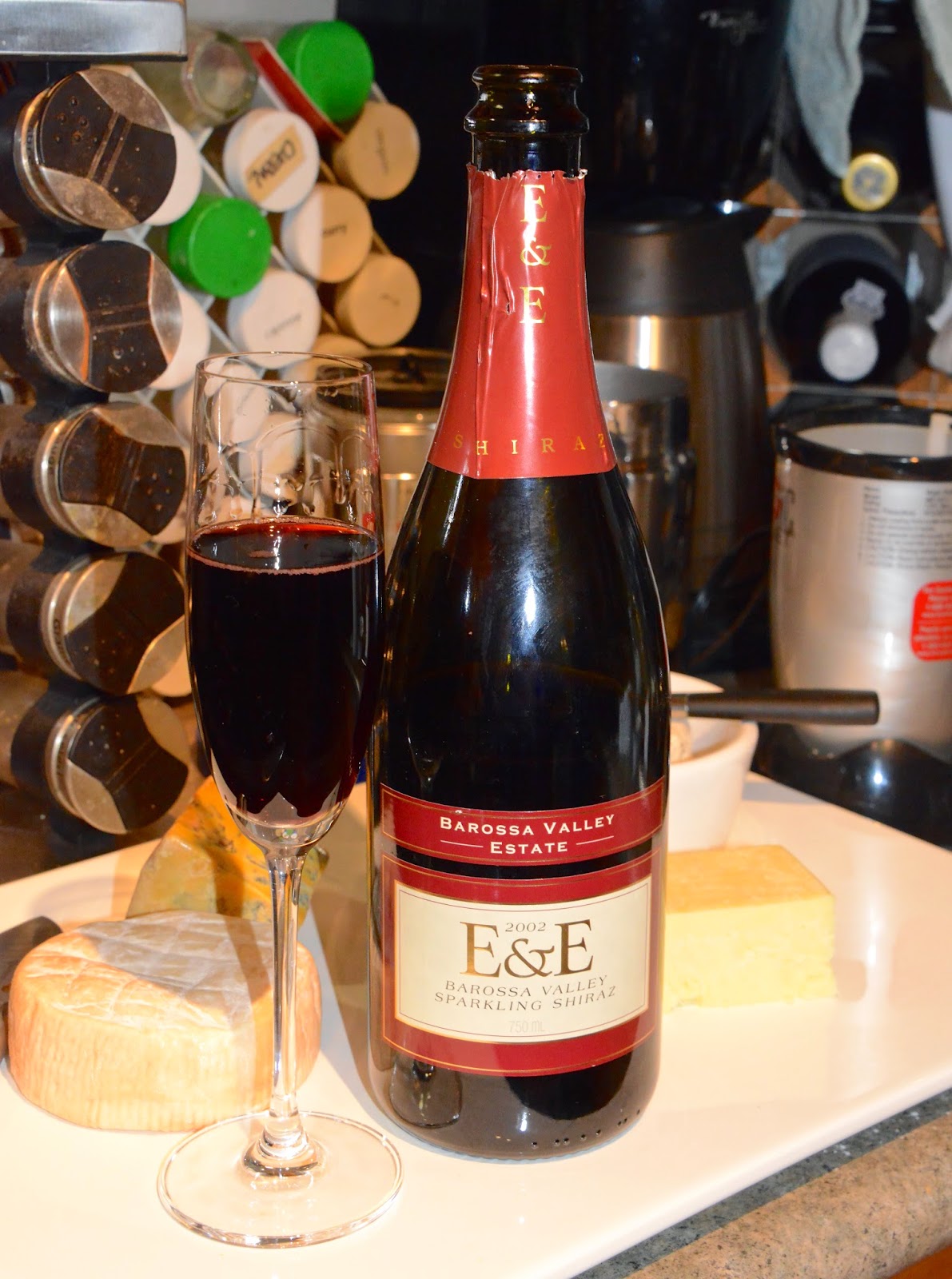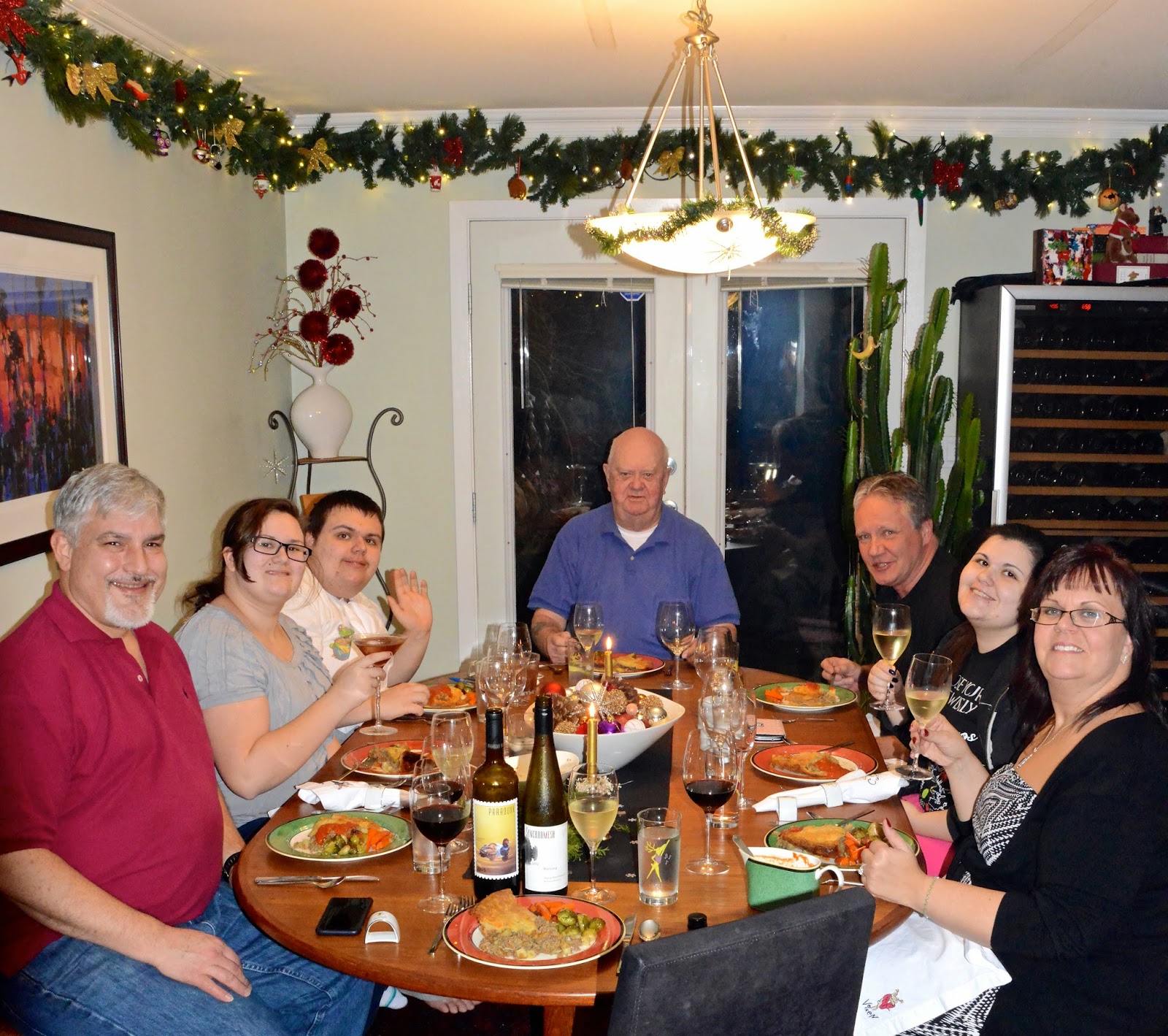Saturday, December 27, 2014
A Little Boxing Day Bubble
Mistletoe, World Junior Hockey and bubbly. How great of a combination is that?
Feeling sorry about the fact that Boo had to miss last night's Christmas dinner because he was working, I invited Dad, Vixen, Big Trucker and the kids to come over to our place for a Boxing Day dinner the next night. The dinner was going to be much lower key but I did decide to pop the corks on some pretty special wines.
1836. 2002 Barossa Valley Estate E&E Sparkling Shiraz (Barossa Valley)
One of the more perplexing questions I've run across while drinking all these bottles of wine is why a bottle of E&E Sparkling Shiraz costs two-thirds the price of a regular bottle of E&E Black Pepper Shiraz. The same premium wine is used and the process of making sparkling wine is way more intensive and costly, but the still wine is the costlier of the two. Go figure. I suppose the idea of Sparkling Shiraz is still mostly a novelty sip outside of Oz.
The end result is that our's is not to question why, our's is just to take advantage of the bargain pricing - "bargain," of course being a relative term when we're still talking $65 bottle - when you can even find it. I haven't seen the sparkling Black Pepper on local shelves for years now. Too bad since this is our last bottle.
This bubbly red isn't likely going to be the first choice of a traditional Champagne lover. Even though the wine is made in the traditional Méthode Champenoise, there's not a lot of mousse filling your mouth and any expected biscuit-y notes are subdued by the bold, dark fruit that's still evident on the palate but I thought it was an interesting start to the evening and was big enough to carry us through until the hockey game ended and Dad was willing to sit down to dinner.
I don't make tourtière very often - indeed, it seems to have become a bit of a rarified, seasonal treat for every second or third Christmas. Tonight's pie - aided by yet another perfect crust from Boo the CrustKing - proved to be a popular treat, even for the picky eaters that the nieces and nephew have become. It certainly didn't hurt that the homemade tomato jam really did taste darned fine with the tortière. Turns out "tomato jam" is just a fancy name for ketchup, but this was the best ketchup I'd ever had.
1837. 2012 Synchromesh Thorny Vines Vineyard Riesling (Naramata Bench - Okanagan Valley)
1838. 2005 Duckhorn Paraduxx (Napa Valley - California)
Being a mix of pork, beef and veal mince, I figured we could likely get away with both a Riesling to cut through richness of the crust and fat and a Napa blend to match up with the meat. When both wines are as good as these two were, I think I could have gotten away with serving a couple pieces of salami with a boiled potato and the wines still seen everyone leave the table happy.
I'd discovered Synchromesh and its racy Rieslings back at the 2013 Wine Bloggers Conference that was held in the Okanagan. They were part of the Okanagan Falls Wine Association gang that took a gaggle of us bloggers hiking up to a spectacular viewpoint and wine tasting. Synchromesh is only a couple of vintages into its production but they're already a label that I'd go out of my way to find. Problem is they just don't make very much. When we drove by the winery early last September, they had already sold out of their 2013 vintage.
While the Synchromesh winery and home vineyard is just outside of Okanagan Falls, this Riesling is made from purchased fruit that is grown on the Naramata Bench - half an hour or so up the road. The vineyard is planted with a single German clone (218) of Riesling and bright with citrus and apple, pear flavours. I haven't seen many Okanagan winemakers marketing the clonal background of their fruit. Maybe this is a sign of a growing sophistication among BC wine drinkers. This was only the third fruit on these vines; so, I'd be really hopeful that the wines to come will be even more complex and tasty.
Paraduxx, on the other hand, has had some time to master its wines and I think it's pretty safe to say that they've done so. The '05 vintage is a Zin dominant (60%) blend with Cab Sauv (32%), Merlot (6%) and Cab Franc (2%) filling out the glass. Although I've had the odd chance to taste Paraduxx at various events, I don't think I've ever had a full bottle before. Even when Boo and I visited Duckhorn, we visited the Anderson Valley vineyards and not Napa. So, they were serving up Duckhorn Pinot Noirs there. It may have take awhile to finally pull the cork on one of these bottles, but I'll just consider it to be a bit of Christmas present to myself.
1839. 1978 Kopke Colheita Port (Portugal)
As fond as I am of Ports and stickies, I can't say that I was familiar with the term "Colheita" when this bottle more-or-less dropped into my lap. A client of our firm was downsizing his home and he needed to divest himself of some Persian carpets. Having a spouse who is an avowed Carpet Queen, I was given the head's up and we visited the client. Boo came away with two carpets.
The downsizing also included the divestment of a good portion of the wine cellar. So, in lieu of a carpet, I picked out a mixed case of Ports. Having married a Portuguesa, our client had an extensive collection of Port wines. This is the first of our dozen to be opened.
Like the term "Colheita," the Kopke winery was equally unfamiliar to me. Founded by a German diplomat in 1638, Kopke has been declared the world's oldest Port house, having celebrated over 375 years of continuous wine production. (Compare that to Synchromesh's five years or so of production). Kopke is also a market leader in Colheita single year tawnies. After a little reading, I've come to learn that Colheita Port must be aged for a minimum of seven years in oak casks before bottling and that the extended time in wood can result in a richer, more viscous wine due to evaporation over the years. That additional ageing also leads to Colheita's distinctive tasting notes, including raisiny fruit, caramel, honey, toasted nuts and oak.
Colheitas are considered mature at 20 years and the bottles should feature two dates on them: the harvest year and the year the wine was bottled. Our bottle's old school, hand stencilled label declares the 1978 vintage and the back label stated that the wine wasn't bottled until 2002.
Tasty stuff - and if the rest of our dozen bottles are just as fine, Boo and I are going to have some rather delightful endings to a few more special dinners. Hopefully, we won't have to wait until next year's holiday season to find reason to pull a few more corks - and an even bigger hope is that Boo will be able to actually join us on Christmas day next year.
Subscribe to:
Post Comments (Atom)















No comments:
Post a Comment